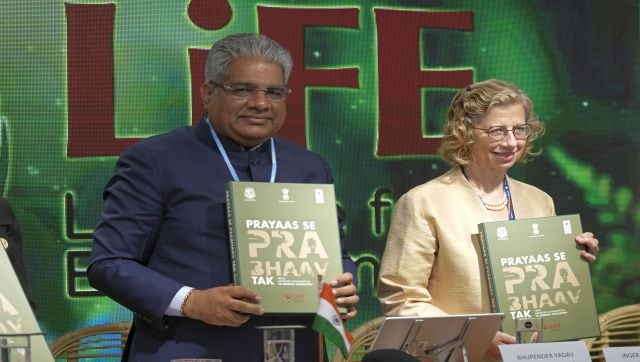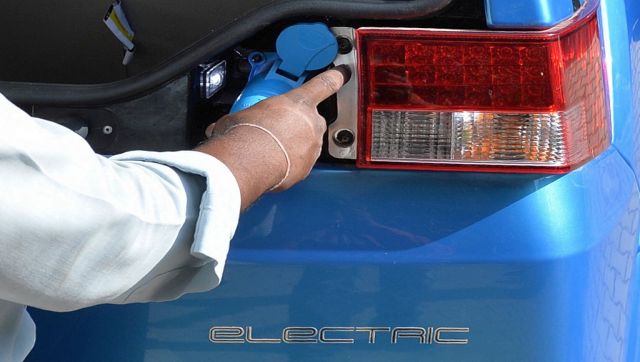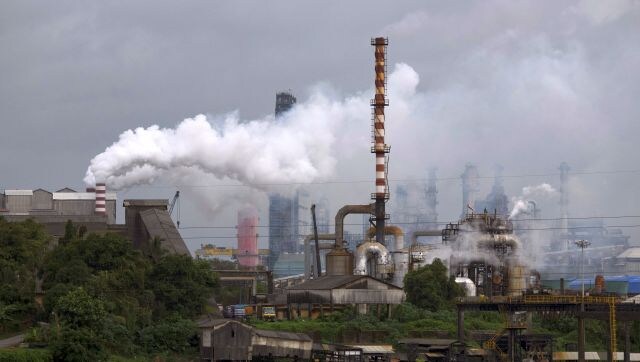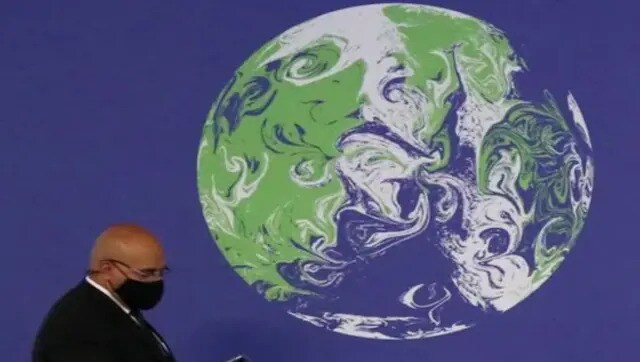Explained: India’s ‘green plan’ to fight climate change at COP27
At the climate summit in Egypt, COP27, India has submitted its Long-Term Low Emission Development Strategy, which outlines its plan to achieve net zero emissions by 2070. The government has stated that it’s looking to boost the use of electric vehicles and maximise the use of hydrogen fuel

Bhupender Yadav, minister of environment, forest and climate change during a session at the India Pavilion at the COP27 UN Climate Summit. AP
At the ongoing climate summit, COP27, being held in Egypt’s Sharm El Sheikh, countries have come together to discuss how to battle climate change and the perils surrounding it.
In this fight, India on Monday, submitted its plan — the Long-Term Low Emission Development Strategy (LT-LEDS) — on reducing its carbon emissions, achieving its net zero goals and becoming a greener country in the future.
Minister for Environment, Forest and Climate Change Bhupender Yadav speaking at the COP27 event, said, “This is an important milestone. Once again India has demonstrated that it walks the talk on climate change.”
India announced that the government’s focus will be on the rational utilisation of national resources with due regard to energy security and the transition from fossil fuels will be undertaken in a just, smooth, sustainable, and all-inclusive manner.
We take an incisive look at India’s plan on going green and how it will reduce carbon emissions — to help slow global warming — and adapt to the impacts of climate change.
Increase electric vehicle penetration
India has announced that it will attempt to reduce its use of fossil fuels and shift to less polluting modes of transport.
To achieve this aim, the country has said that it will introduce and implement programmes and policies to boost domestic manufacturing of electric vehicles.
In the over 100-page long document submitted, India has said that it will move towards faster adoption and manufacturing of hybrid and electric vehicles.
It will also explore the implementation of vehicle-grid integration options, to enable planning of increased load on the electricity grid.
The country is already seeing a transition to electric vehicles, despite the fact that the majority of vehicles still run on gasoline. In October 2022, total electric vehicle sales grew month over month by 28.1 per cent to 1,19,889 units. Additionally, there was a year-on-year increase of over 200 per cent. Sales of electric vehicles picked up in 2022, increasing up to 200 per cent for all two-wheeler, three-wheeler, and four-wheelers. This shows that people are dedicated to buying EVs.

In October 2022, total electric vehicle sales grew month over month by 28.1 per cent to 1,19,889 units. AFP
Increasing the use of biofuels
As per the LT-LEDS, India will focus on increasing its use of biofuels. India aims to achieve 20 per cent blending of ethanol with petrol and five per cent blending of biodiesel with diesel by 2030.
It has also committed to increasing ethanol production facilities across the country and provide these units with financial support.
This will be very helpful in India reducing its overall carbon emissions. As per government data, in the the last seven years, carbon emissions have reduced to be 22.6 MtCO2 owing to the programme for Ethanol Blended Petrol. In 2020-21 alone, a reduction of 6.44 MtCO2 was achieved due to this program.
****
Explained: Why India is a key player at COP27
COP27: What is the Mangrove Alliance for Climate that India has joined?
Ankith Suhas Rao: The 16-year-old climate warrior from India who will speak at COP27
Burnishing India’s image: How Narendra Modi turned climate challenge into an opportunity
****
Going the hydrogen way
One of the methods that India is opting for to reduce its carbon emissions is to maximise the use of green hydrogen fuel. Keeping this in mind, India has already launched the National Hydrogen Mission last year.
As part of this mission, India is likely to mandate energy-guzzling industries – like refineries, fertiliser, among others – to use green hydrogen and green ammonia in a phased manner and also offer production-linked incentives.
Reliance Industries Ltd has already stated that it aims to transition to green hydrogen production, from grey now, by 2025. The Adani Group also recently announced that it has entered into a partnership with TotalEnergies of France to develop a green hydrogen ecosystem.
Adopting ‘LiFE – Lifestyle for Environment’
Besides the above mentioned steps to reduce carbon emissions, India has also batted for the adoption of LiFE — Lifestyle for Environment, a mantra coined by Prime Minister Narendra Modi and launched on 20 October.
The underlying philosophy of LiFE has its roots in India’s ancient saying: ‘Nature protects if she is protected’. LiFE aims to promote globally the practice of a lifestyle that is synchronous with nature and does not harm it, by individuals and communities. It proposes to bring about a fundamental change in both the way we produce and the way we consume.
To adopt LiFe, one has to practice simple yet effective environment-friendly actions in their daily lives — be more mindful of one’s water and energy consumption, reduce single-use plastic consumption and reduce overall wastage.

Steam emits from a crude oil refinery in Kochi, Kerala. India is one of the world’s largest carbon emitters. AP
Carbon emissions continue to pollute
An environmental study shows that global carbon dioxide emissions from all human activities remain at record highs in 2022.
The study, carried out by Global Carbon Project, calculates Earth’s “carbon budget”, which is how much CO₂ humans have released, and how much has been removed from the atmosphere by the oceans and land ecosystems.
According to the study, the world is projected to emit 40.6 billion tons of CO₂ from all human activities, leaving 380 billion tons of CO₂ as the remaining carbon budget. This amount of emissions is disastrous for the climate—at current levels, there is a 50 per cent chance the planet will reach the 1.5 degrees Celsius global average temperature rise in just nine years.
The findings are in line with other recent reports, including from the United Nations’s climate office, warning that the world is “nowhere near” hitting its targets to cut greenhouse gas emissions.
“This is more evidence that time is running out,” Pierre Friedlingstein, a climate modeler at the University of Exeter in the United Kingdom and lead author of the study was quoted as saying.
With inputs from agencies
Read all the Latest News, Trending News, Cricket News, Bollywood News,
India News and Entertainment News here. Follow us on Facebook, Twitter and Instagram.
also read

COP27: Who are the movers and shakers of climate finance?
In recent years, countries from the Global South have pushed for a financial mechanism to compensate for damages. But the United States and Europe never wanted it and will not support the creation of a new fund

UN climate summit opens in Egypt, India focuses on climate finance
The 27th Conference of Parties to UNFCCC will see India seeking clarity on the definition of climate finance, whether it is grants, loans, or subsidies, and nudging developed countries to enhance the supply of technology and finance needed to address climate change and resulting disasters

Three things that world leaders should be aware of ahead of COP27
Research suggests that we’re on the brink of passing major climate ‘tipping points’ like the collapse of Greenland’s ice sheet. Passing these points will lock the planet into continuing damage to the climate, even if all greenhouse gas emissions cease
